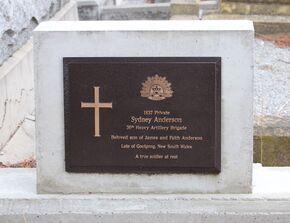ANDERSON, Sydney
| Service Number: | 1837 |
|---|---|
| Enlisted: | 2 August 1915, 12th Reinforcements |
| Last Rank: | Gunner |
| Last Unit: | Field Artillery Brigades |
| Born: | Gooloogong, New South Wales, Australia, 1897 |
| Home Town: | Gooloogong, Cowra, New South Wales |
| Schooling: | Not yet discovered |
| Occupation: | Hotel worker and horse trainer |
| Died: | Poisoning, Hobart, Tasmania, Australia, 20 October 1927 |
| Cemetery: |
Cornelian Bay Cemetery and Crematorium, Tasmania Free Scotland, F, Number 63 |
| Memorials: | Cowra & District Great War Honor Roll, Gooloogong District Roll of Honour |
World War 1 Service
| 2 Aug 1915: | Enlisted AIF WW1, Private, 1837, 6th Light Horse Regiment, 12th Reinforcements | |
|---|---|---|
| 20 Dec 1915: | Involvement Private, 1837, 6th Light Horse Regiment, --- :embarkation_roll: roll_number: '2' embarkation_place: Sydney embarkation_ship: HMAT Aeneas embarkation_ship_number: A60 public_note: '' | |
| 20 Dec 1915: | Embarked Private, 1837, 6th Light Horse Regiment, HMAT Aeneas, Sydney | |
| 28 Mar 1916: | Transferred AIF WW1, Gunner, Field Artillery Brigades, 114th Howitzer Battery |
Help us honour Sydney Anderson's service by contributing information, stories, and images so that they can be preserved for future generations.
Add my storyBiography contributed by T A Rumble
Born in 1897 in Gooloogong, NSW, Sydney (Sid) Anderson, was the second eldest son of James, a carpenter and hotelier, and his second wife, Faith Elizabeth Anderson (nèe Potter). He was the younger brother of James Dudley Anderson, who was better known as Dudley (6027).
As a young boy, Sid lived in Main Street, Gooloogong. When he enlisted in the AIF on 2 August 1915, he was 19 years of age and working in Cowra, NSW at the Court House Hotel. Perhaps hoping to join a Light Horse regiment, Sid declared on his enlistment papers that he was a horse-trainer rather than a hotel worker.
Prior to departing overseas, Sid was guest of honour at two separate farewells. At a reception held in the Centennial Hall in Cowra, he was given a wristwatch from his work colleagues; and a safety razor and sheepskin waistcoat from his friends. In Gooloogong, he was gifted an engraved ring and a fountain pen. The ring was described in farewell speeches as an ‘engagement ring’; meaning for ‘engagement’ with the enemy.
Allocated to the 6th Light Horse, Sid departed for Egypt on HMAT Aeneas on 20 December 1915. A detailed letter he wrote about the voyage was published in the Cowra Free Press on 8 March 1916. In the letter, Sid described the daily routine of the men on board and how he spent a lonely New Year's Eve at sea, on guard duty.
Sid and the other reinforcements arrived in Egypt in early 1916. When he was finally taken on strength near Maadi, Egypt on 28 March 1916, Sid had been transferred from the Light Horse to a newly formed artillery unit, the 114th Howitzer Battery. This and other artillery and Light Horse units were an integral part of the ANZAC Mounted Division's defense of the Suez Canal, a critical supply route for British and Dominion forces.
In the harsh desert and combat conditions, Sid’s health declined almost immediately. He was finally admitted to the 3rd Auxiliary Hospital in Cairo on 24 May 1916 suffering from a recurring stomach complaint. Within 6 weeks, he was invalided back to Australia. The return journey was not without incident when HMAT Clan McGillivray encountered a cyclone and was thrown more than 200 miles off course.
On his return to Cowra on 18 August 1916, Sid was met with a hero’s welcome. The festive reception at the Cowra Railway Station was in stark contrast to how Sid felt about his war experience.
Sid left the Cowra district around 1920 and relocated to Tasmania. He initially worked as a labourer but badly injured his hand in an accident in the Hobart railway yards. He then worked as a motor driver, carrying goods for the licensee of the Freemasons Hotel in New Norfolk, Tasmania.
Sid became engaged to Miss Vera Branch, an employee of another local hotel. Although he was a heavy drinker, without any warning, on 20 October 1927, Sid consumed Lysol and a few hours later died at the Hobart Public Hospital. An inquest into his death could not determine whether the poison was consumed intentionally.
While Sid’s military style funeral was well attended, until recently he lay in an unmarked grave in the Cornelian Bay Cemetery in Hobart. To honour his service, the Headstone Project (Tas) recently installed a headstone for Sid, stating, ‘Beloved son of James and Faith Anderson. Late of Goolgong (sic). A true soldier at rest’.
Sydney Anderson is the 4th name recorded on the Honour Roll at the Soldiers’ Memorial Hospital, Canowindra (/explore/memorials/14455), NSW. His name is immediately below that of his older brother Dudley. Sid's name is also recorded on the Gooloogong District Rolls of Honour (placesofpride.awm.gov.au) and the Cowra and District Great War Honour Roll (/explore/memorials/4634).
Contributed by Tracey Rumble for the Canowindra Historical Society and Museum









